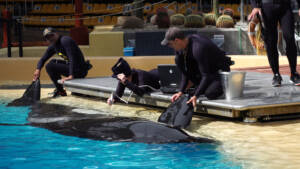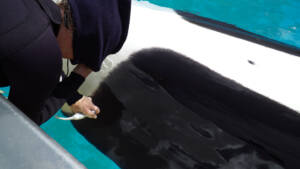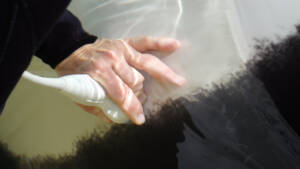A scientific study carried out by international experts in cetacean health reveals the first evidence of the harmful effects that contraceptives have on orcas and contributes to understanding how the chemical pollution of the seas affects the reproduction of cetaceans. The study led by veterinary specialist Doctor Geraldine Lacave and recently presented at the International Congress on Aquatic Animal Medicine held in South Africa, demonstrates the serious damage that chemical toxins cause in regular ovulation cycles, thus affecting the reproduction of this species of cetacean in the long term.
The suspicion that chemical toxins such as PCBs (polychlorinated biphenyls) interfere with oestrogen receptors (female sex hormones that regulate reproductive cycles in orcas) and affect the reproduction of marine species dates back in time. However, it was from the case study of the orca Lulu, stranded in 2017, in Scotland, when the concern for the study of the effect of oestrogens was markedly accentuated, since this female had the highest levels of PCBs found so far and evidence was found that she had never reproduced.
In this regard and in order to investigate the matter, Dr. Lacave analysed more than 57,000 videos of the ovaries of the orcas housed in Loro Parque, Tenerife, obtained during more than 4,500 ultrasounds performed by the veterinarians and trainers of this zoo since 2012. And it was thanks to access to this information that it has been possible to reconstruct the entire process of ovulation of the orcas. It should be noted that this type of research can only be done with animals in controlled environments such as zoos, as it requires regular access to the animals to be able to perform ultrasounds and follow in detail the entire process of ovulation of the females.
Thanks to this opportunity to carefully analyse the ovulation of orcas, dozens of ovulations have been followed day by day and irregular cycles have been detected (abnormally shortened or lengthened), as well as cycle delays, very long periods without ovulation, follicular cysts and even one ovulation during contraceptive treatment. Given that this study has been carried out more intensively in the last five years, there is still no information available on the problems that could be caused by long-term contraceptive treatments, but the intensity and variety of the ovulatory problems give reason to suspect that they could be serious. Since it’s believed that PCBs could block oestrogen receptors in orcas by a mechanism similar to that of contraceptives, these results would explain that even small concentrations of these toxic substances seriously affect the reproductive cycles of the orcas, reducing their fertility.
The most important thing about this scientific finding is that the information studied in the zoo will contribute to the conservation of this species of cetacean in nature, since the knowledge obtained of how oestrogens affect and disturb regular cycles in orcas could help to understand how chemical pollution is affecting the reproduction of the wild populations, not only of orcas, but also of dolphins, and in the future of other species of marine mammals. This is clear evidence of the role modern zoos play in species conservation.













